
Product test
Microsoft Surface Pro 7 tested: USB-C and Ice Lake U processors at last
by Martin Jud

Cheekily copied or well improved? Dell takes up the design of Microsoft's Surface Pro with the Latitude 7200. What does Dell do differently?
With a Windows 10-based convertible, you can kill three birds with one stone. You get a tablet that turns into a notebook when needed. It is also suitable for normal office work thanks to its great software compatibility, unlike Android or iOS-based systems.
Dell launches the Latitude 7200, a Surface Pro clone at a better price.
Dell does a few things differently to Microsoft in the details. This is not just limited to the exterior, such as the hinges of the stand or the less high-resolution display. Dell uses eighth-generation Intel processors in the Latitude - Microsoft is already using the tenth generation with WiFi 6 and Iris Plus Graphics. However, this does not necessarily mean a big performance boost: Unlike Microsoft, Dell gives the i5 active cooling. This presumably allows the device to clock up for longer. In the test linked above, the Surface Pro 7 limited the clock frequency to 44 per cent of performance after just a few minutes in order to avoid heat death.
By the way: Unlike Microsoft, Dell already includes the plug-in keyboard in the price.
The technical data:
The chassis is made of aluminium and magnesium and measures 29.20 x 20.88 x 0.93 centimetres without the keyboard. This means it has almost the same dimensions as the Surface Pro. This also applies to the display edges with a width of 1.5 centimetres. However, the Dell clone weighs slightly more at 851 grams compared to 770 grams.
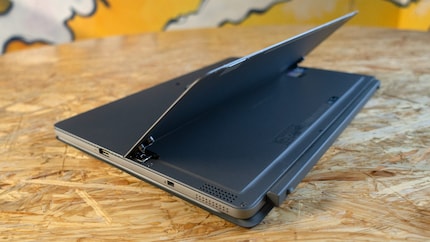
When opening the stand for the first time, I notice that the hinge movement feels a little less smooth than with Microsoft. On the other hand, Dell has equipped it with an additional function that works with and without the keyboard plugged in. There are two spring contact pins on the underside of the device and at the keyboard attachment point. These should be activated automatically when placed on the table and open the stand by 26 degrees. If you want a larger angle, the stand can be opened up to 150 degrees by hand.
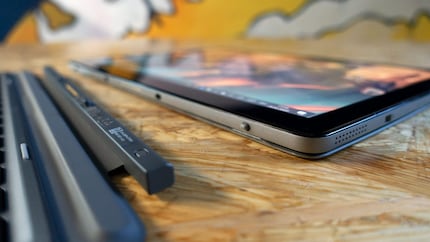
As for the auto-folding mechanism, I can say that if you just place the convertible on the table as normal, it usually doesn't work. Hammering on the table works well, but is not advisable. The magic happens when you place the device on the table, then press gently from above and feel the spring contact pins go down gently or the edge of the keyboard kisses the tabletop.

Dell is not stingy and provides the Latitude with two Thunderbolt 3 ports on the left side, one of which is also used for charging. There is also a microSD slot, a volume rocker and a 3.5 mm jack connection on the left.
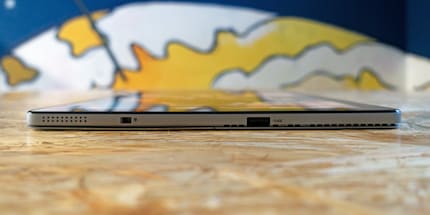
On the right-hand side, you also have the option of connecting older devices without a USB-C adapter thanks to USB 3.1 Type-A. There is also a Kensington lock. Dell has placed the power button at the top right of the tablet.
The biggest difference to the Surface Pro is probably the built-in glossy display. More precisely: the resolution of the 12.3" IPS multi-touch display in 3:2 format. Microsoft offers 2736 x 1824 pixels, while Dell gives you 1920 x 1280 pixels. With the given diagonal of 12.3 inches, this is enough to get a sharp image at a normal display distance. If you employ a pen, you will notice the lower resolution as you are much closer to the display with your head.
To find out how well the display is illuminated and reproduces colours, I measure it with the x-rite i1Display Pro:
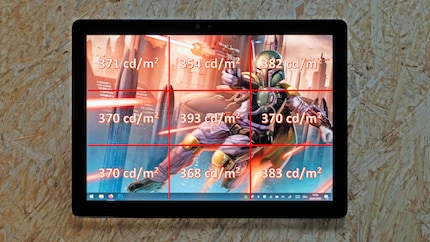
As the measurement shows, the built-in panel is bright enough to work almost anywhere with an average of 373 cd/m². Only direct sunlight causes problems due to the high-gloss coating. The uniformity is also good - I can't see the maximum difference of 39 cd/m² with the naked eye. If I compare it to the Surface Pro 7 again, the Microsoft convertible is 59 cd/m² brighter on average.
However, the colour space coverage of the Dell is somewhat more accurate. I measured 98.5 per cent for sRGB, 70.5 per cent for Adobe RGB and 74.6 per cent for DCI P3. The static contrast of the test model is a crisp 1313:1, the dynamic 4238:1.
I like the fact that the 349 gram keyboard is included in the price. However, it is clear from the very first moment that it has room for improvement. Like the Surface Pro keyboard, it automatically attaches itself to the tablet. Thanks to built-in magnets, it can be used both flat and at an angle. However, when angled, it rocks slightly sideways when I place the palm of my hand on it due to its design-related instability. Fortunately, I quickly get used to it.

Dell has opted for a grey imitation leather on the underside. The palms are made of aluminium, which feels cool and hard. The keys have two-stage illumination. Compared to Microsoft's plug-in keyboards, the keys bounce considerably less. When you type, you also feel a strong trigger point. The key travel is 1.4 millimetres and the typing feel is quite pleasant after a familiarisation phase. If you want to work in an open-plan office, the keyboard is also suitable thanks to the rather quiet typing noise.
Thanks to the very smooth surface of the trackpad, you can move the mouse pointer around the screen with pinpoint accuracy. I have nothing to criticise about the trackpad.
If you like to watch a film or enjoy music without headphones from time to time, this is only an option if your hearing is no longer the best. As is often the case in the notebook segment, the speakers are rather poor. But unlike other poor notebook speakers, it's not just individual instruments such as pianos and electric guitars that sound distorted. The worm is in the entire mid and bass range - the music quickly sounds muffled. I only find high frequencies to be clean - at least in the moments when they don't overlap.
Sorry Dell, you'll have to work on that again.
Now the lithium-ion battery with 38 Wh can show how much juice it brings to the convertible. I measure the runtime when continuously streaming YouTube videos, at maximum performance and during office work.
To draw a comparison with other notebooks and convertibles, I set the brightness of the display to 150 cd/m² and run music videos on YouTube until the juice runs out. After 5 hours and 49 minutes it's over. That's not a brilliant performance, but at least it's more than the Surface Pro 7 with a larger battery managed. With 45 Wh, it only managed 5 hours and 16 minutes in my test.
To push all the hardware to its limits, I ran the HeavyLoad and FurMark stress tests simultaneously with the screen set to maximum brightness. As with the Microsoft convertible, I observe how the CPU is throttled down after a while. Thanks to active cooling, it takes about ten minutes for the throttling to reach 57 per cent of performance. On the passively cooled Surface Pro 7 with an i5 processor, the processor clocks down to 44 per cent of performance after around five minutes.
If you want to use the convertible as a mobile office, you should not use it on your lap. The stand of this device category is not suitable for this and often folds away, which can turn into an egg dance in public transport.
Despite the undersized battery, I manage a runtime of around eight hours in office mode. I refrained from playing music in the background while I was working
Important! The Latitude 7200 model linked above has the Core i5-8365u and not the Core i5-8265u as in the model Martin tested in Switzerland. The i5-8365u is a new variant of the chipset, which performs slightly better overall than the i5-8265u in other tests. In other words, the following statements on performance do not match the 2-in-1 linked above 100 per cent, but they are very close. And now on with the text.
The 64-bit quad-core x86 microprocessor Intel Core i5-8265U was launched at the end of August 2018. It is based on an improved version of the Whiskey Lake microarchitecture and is manufactured using the extended third generation of the 14 nm process, known as 14 nm++. It employees at a clock speed of 1.6 GHz and has a TDP of 15 W. The turbo boost is up to 3.9 GHz.
The chip also features Intel's UHD Graphics 620, which runs at 300 MHz and has a maximum dynamic frequency of 1.1 GHz.
With Cinebench from Maxon, you can test how your processor performs when rendering Cinema 4D content. If you want to compare multi-core results, this is only possible if both processors have the same number of threads.
How the Dell convertible performs:
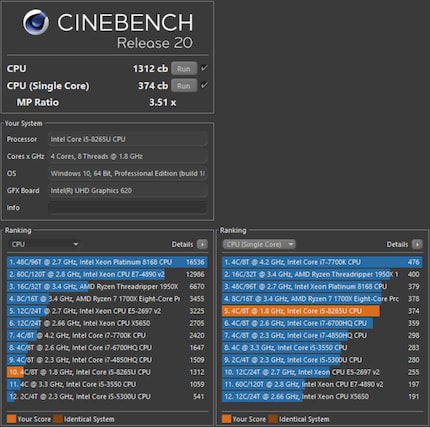
According to Intel, the Whiskey Lake microarchitecture of the processor installed here should be able to process around 18 per cent fewer IPCs (instructions per clock) than the new Sunnycove microarchitecture on which the processor installed in Microsoft's Surface Pro 7 (i5-1035G4) is based. This processor should perform worse. But the result is not that clear-cut: although Dell's 1312 points in the multi-core result do not come close to Microsoft's 1504 points, the Dell device beats the Surface in the single-core result with a score of 374 to 361.
Dell probably gets a lot out of it thanks to the active cooling: The multi-core benchmark takes less than four minutes, which is why the passively cooled processor of the Surface convertible is not yet throttled down and leaves the Dell device behind. In contrast, the single-core benchmark takes around 13 minutes and seems to have the opposite effect. Long live the cooling, which can only be heard through a quiet hiss when the device is under load.
Geekbench is a cross-platform benchmark. Geekbench runs on Windows, MacOS, Linux, Android and iOS. In addition to simulated real-world scenarios with which the CPU is tested (single-core and multi-core), Geekbench can also determine GPU performance in the areas of image processing and machine vision. Thanks to the Geekbench browser, you can compare the results with other systems.
The result of the Latitude 7200:

The CPU and GPU benchmarks take under three minutes on Geekbench, which is why the result here is as expected and the older processor from Dell delivers the worse results in the comparison with the Surface Pro 7.
If you would like to see the results in detail:
Thanks to PCMark 10 from 3DMark, PCs and notebooks can be tested for the various tasks at a workplace. It is an office benchmark and is suitable for all devices for which a gaming benchmark makes no sense due to weak hardware.
The Latitude 7200 scores 3570 points in this benchmark. If you compare the result on the 3DMark homepage, you can see that this device performs better than an average office PC, but not good enough to be considered a weak gaming PC.
At first glance, Dell manages to copy Microsoft's Surface Pro concept. But on closer inspection, there are a few differences. These start with the hinges and the workmanship, where the Microsoft device feels slightly better, but Dell can score points with a stand-folding mechanism. As for the keyboard, which is included in Dell's price, I like the typing feel a little less than with Microsoft. The fact that the Dell keyboard feels a little wobbly when used at an angle is only annoying until you get used to it.
Microsoft's screen has a higher resolution, which is particularly important for pen input. In terms of colour space coverage, the points again go to Dell. And in terms of battery life, the Latitude is minimally ahead despite its smaller battery. However, it is left behind in terms of sound reproduction, which has a lot of room for improvement.
In terms of performance, Dell has done everything right - despite the slightly older eighth-generation i5 processor. The device has active cooling, which is important for longer rendering tasks, for example.
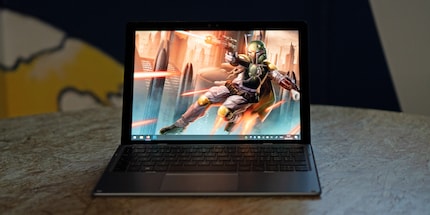
Dell has managed to create an interesting, but not perfect clone. If you can do without good sound output and prefer not to use pen input, I can recommend the device.
I find my muse in everything. When I don’t, I draw inspiration from daydreaming. After all, if you dream, you don’t sleep through life.